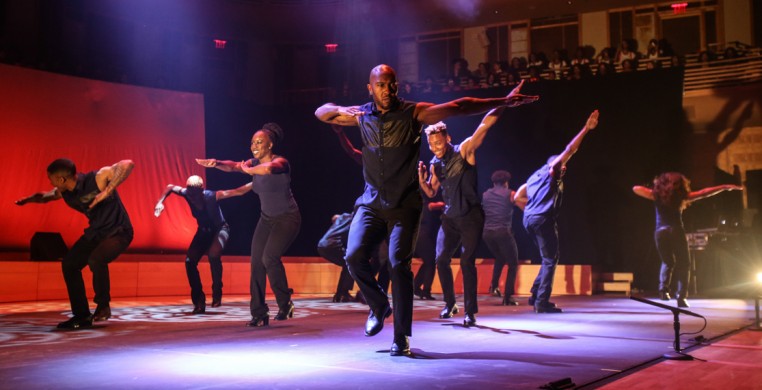My first experience seeing Step Afrika perform was fifteen years ago in Washington D.C. Founded by C. Brian Williams, I remember being stunned at that time by the striking parallels made between Africa and African American Fraternities and Sororities. However, the connection didn’t resonate for me in a full way until Saturday night.
On January 7th, during the height of the Divine 9 Founders’ Days, the most recent Step Afrika performance at the historic Auditorium Theatre in Chicago welcomed thousands of fans into the opulent theatre for entertainment, education and a glimpse of nostalgia.
The program was oozing with all things African: call and response, community circles, healthy competition, polyrhythms and vibrant soloists. We were swept into a world offering the excitement of a basketball game and the artistic rigor of Alvin Ailey Dancers. The performance was a lit pool of dance styles highlighting influences from South African Gumboot Dance, Jazz, Hip-hop, Kongo Kamba, Corn Shucking, African American Stepping and so much more.
The seamless integration of diverse styles from across the African Diaspora is not a new aesthetic, however it is not easy to bring all these languages into discourse with one another while remaining succinct and comprehensible. Step Afrika understood the assignment, while simultaneously generating our collective excitement.
Sacred geometry took center stage in the opening number as the nine divine performers began with a circle that formed a precise line and later diffused into a regal pyramid. The simple formation of these powerful shapes, black attire and a ready stance, reminded us that we come with everything we need. And with a voice, our bodies, our memory and the collective support of one another, we will prevail.
Coral blue flooded the almost bare stage where six male dancers began spitting out ripples of precise Mbele-inspired knife-like slices with their arms. The stepping was football field explosive, reminding us that every seat was a good seat for this performance. Percussive rhythms accompanied “how low can you go” back bends with a beautiful blend of RUN DMC meets HBCU step show crowd energy. The crew left it all on stage showcasing their individuality in every solo and their brotherhood as a unit.
 Photo by Sekou Luke
Photo by Sekou Luke
Of course, the ladies did not disappoint. Painting the stage red with their sensual S-patterned steps, adding complex rhythm patterns, throwing in envious arabesques and high kicks to remind us they don’t only speak the language of stepping, but they are in fact polyglots.
Energy catapulted as the audience was encouraged to participate in the fun! Nothing says step show more than a little competition, and things got heated as the ladies and gents went toe to toe for the crown of the best steppers in all of Step Afrika’s history. After several “bring it on” battles, and crowd cosigning, the host determined the best team was the entire team because in classic Ubuntu fashion, “I am because we are.”
Simmering down the stadium-like energy was a gorgeous black and white film that gave more historical context around Step-Afrika’s extensive journey, featuring highlights from the company’s global workshops, African American fraternities and sororities, Jazz dancing, South African Gumboot Dancing and so much more. It was a vibrant kaleidoscope of the elements that make Step Afrika a true reflection of the African American dance aesthetic.
Following the film, I felt a strong sense of affirmation. For me, they could have ended the show at that point. I was full of pride as a black woman, as an HBCU grad and as an artist who studied in South Africa. The film was a moving photo album of so many of my experiences and I felt seen. By the show of the applause and verbal responses I know that many others did as well. Thankfully, the show was just getting started as two Doundoun drummers took center stage.
Blessing us with literally the most striking doundoun drumming I’ve ever seen, the duo resonated a pulse that reverberated throughout the entire theatre. The performance was exhilarating. I remember thinking, “Oh, we can do this too?” A lengthy soloist joined the duo isolating her lower body with a wiggly contemporary rendition of something Josephine Baker. Her leg lifts and ways of dancing were “nasty” in the best way, I just scrunched my lips and shook my head because she left me speechless. When the ensemble joined the soloist, dressed in Zulu Regalia we knew the performance was getting ready to peak. They brought the stepping back full circle as we could see the direct influence of the high kicks, stamping, arm slices, and body pats living in the traditional South African Gumboot dancing, a style of dance which began during South African Apartheid from workers in mines who used intricate foot patterns to communicate with one another. It reminded me that communication with one another is perhaps one of our most sacred tools, as isolation was the colonizers most popular weapon of destruction. The story is similar throughout the African Diaspora where we repurposed whatever we could get our hands on to communicate with one another as a form of resistance but more importantly as a means for survival.
Let us also remember that communication is for more than resistance and survival, it is also for our enjoyment. The doundoun drummers reminded us of this as they played the beat from “Where my eyes can see” by Busta Rhymes. The crowd picked it up immediately and went wild!
It was a night to be remembered. Thousands of people assembled into an intergenerational crowd of onlookers sharing nostalgic moments, largely resurrected by the diverse sounds of Step Afrika. From hand claps, to foot stamps, to thigh smacks, to belting voices, to resounding drums, for 90 minutes we were submerged in “Sounds of blackness.” It felt damn good to be a part of the sensitivity, superpower and endless nuance of this community.


